Slacktivism: Powerful Tool or Just a Distraction
If you have been remotely active on social media over the last few years, it’s likely you’ve witnessed the rise in online activism. Whether they were about saving sea turtles or social justice, it’s probable that you have encountered posts about some of the important issues facing the world while clicking through your feed.
This online activism is increasingly a key component of how people use and interact with social media platforms in the modern word. Online platforms have become an important organizing tool for political campaigns and movements, as well as a resource people can use to spread awareness of political issues and their views. Political organizing and other strategic uses of the internet are one thing, but what about slacktivism? Does idly sharing a post about some abstract issue create any meaningful change?
The term “slacktivism” comes from the combination of “slack” and “activism”, describing a form of online activism that doesn’t require much effort. Whether it is signing a petition, “liking” something, or sharing a post, slacktivism is differentiated from more active forms of activism by its lack of significant effort or involvement. Sharing a post is certainly much easier than knocking doors or marching in the street, but does that mean it’s less effective?
The arguments in favor and against slacktivism:
The argument against slacktivism generally comes down to the low-effort nature of it. Since it is, by definition, an endeavor that requires little energy or continuous involvement, it is often criticized as not actually being an effective means of creating change. According to the Pew Research Center, around 75% of American adults think that social media can make people think they’re making a difference even though they are not. Furthermore, some say that slacktivism is less about affecting real change and more about feeling like you’re helping so that you feel better about yourself. In a similar vein, there is a performative aspect to slacktivism that does raise the question of whether people are engaging in it because they genuinely care or simply as a form of virtue signalling.
Others point out that the democratic and decentralized nature of social media allows anyone to have a voice and that by (for example) sharing a post about the negative effect that plastic pollution has on sea turtles, an individual can spread awareness about a pressing issue. If their followers then share that post with more people, a large group of people has been informed about something they otherwise might not know about. The argument goes that even though sharing the post alone isn’t helping the turtles directly, by spreading awareness someone can inform others of the problem, prompting more people to take action. Some individuals are not in a place where they can engage in more active forms of activism, and social media creates a platform that anyone can use to spread awareness about important issues.
How Americans feel:
In general, the American public sees social media as something that can serve to distract from important issues, but also something that can be used positively in the political arena. In particular, social media is seen as able to highlight important issues that may not get much coverage and to give a voice to underrepresented groups. Below is data from the Pew Research Center.
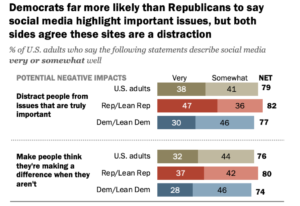
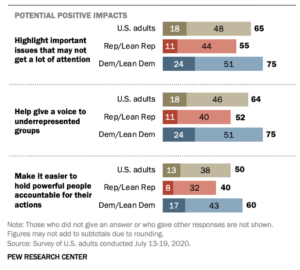
In order to get a sense for how my peers feel, I polled my hall on a range of similar questions, and the highlights are below. It is interesting to note that though a vast majority has shared activist posts, the respondents were generally uncertain as to whether the posts had an effect. It is also interesting to note that a majority experienced fatigue from seeing such posts, a phenomenon that could be interesting to investigate further. They were additionally somewhat cynical in their assessment of people’s motives, with almost 97% saying that people who share posts do so more to feel like they’re helping than because they care deeply, and vast majority characterized performative activism as a problem on social media.
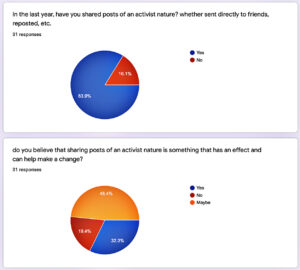
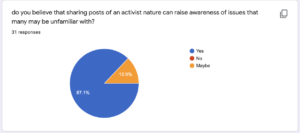
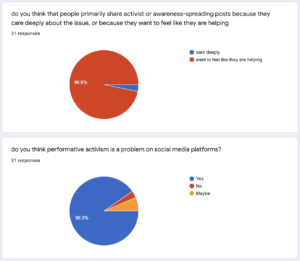
For a more in depth response, I conducted a short interview with a freshman college student. Below is a snippet from the interview.
Transcript: “I think social media can be advantageous for those hoping to spread activism, however I think there definitely are some drawbacks as well as the positives. For one, I think that it’s easy to be a mindless consumer of social media so seeing several posts regarding activism isn’t actually as impactful as one may think. However, I think that if you’re a conscious user of social media, watching these posts and seeing the same posts over and over again may spark your interest in a subject and impact your personal decisions, but I’m not sure that’s effective on a mass scale.”
The general consensus seems to be that people see Slacktivism as a very flawed form of seeking change, but still one that can be valuable for spreading awareness. The interviewee raised the point that even if they spread awareness, the posts may not spur readers to action, which is perhaps slacktivism’s greatest hurdle.
Conclusion:
Slacktivism cannot be understood without understanding the social media platforms that make it possible. Because of the way in which things can go viral, all the slacktivist campaigns that have had the furthest reach have in some ways become a viral trend not all that different from any other random trend. People post things, sometimes challenging their followers to do the same, and all of the sudden it seems like everyone is posting about the topic. Then, as quickly as it started, it dies down as people move on and some other topic takes over their collective consciousness. This is perhaps both its biggest strength and greatest weakness. The viral nature of many slacktivist campaigns means that millions upon millions of people can be reached, but their lack of staying power means that they all too often peter out before anything has actually changed. Relying on the posts about serious issues to go viral in order to spread awareness also affects the type of posts that do. Anecdotally, as far as my experience on Instagram these last four years is concerned, I have found that the types of posts that go viral are generally pretty similar. At the most basic level they boil down to trying to help a “victim”. Whether the victim is an animal species being hurt by pollution, a rainforest burning down, targets of political oppression, or those killed in a massacre, the general narrative created by the posts is one of a victim who needs to be saved; sharing the post is implied to be a step towards saving them. This approach may be effective at galvanizing support but it relies on creating a very simple narrative of good vs. evil that overlooks any nuance of the situation. In addition, it strips the “victims” of any agency and portrays them as entirely helpless and at the mercy of the aggressors. Whether this representation is accurate is above my pay grade, but it is interesting to note that almost all of the viral slacktivist campaigns I have witnessed on Instagram fundamentally explained the issue they were about as a trope of victim vs. aggressor.
Online activism is undeniably a tool that can be used to spread awareness, but it is important to remember that sharing a post alone cannot create meaningful change. Next time you see a post about some environmental issue, don’t just share it and go on with your day happy that you’ve done your part. Ask yourself whether the way you live your life contributes to that issue and whether you can do anything meaningful to have a positive impact, even if it’s just a small lifestyle change. After that, feel free to share the post with as many folks as you’d like.
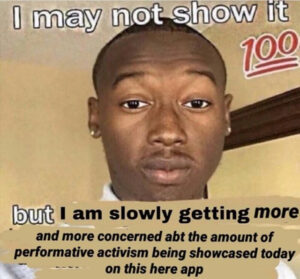
Citations:
Anderson, Monica, et al. “Activism in the Social Media Age.” Pew Research Center: Internet, Science & Tech, Pew Research Center, 28 Aug. 2020, www.pewresearch.org/internet/2018/07/11/public-attitudes-toward-political-engagement-on-social-media.
Auxier, Brooke, and Colleen McClain. “Americans Think Social Media Can Help Build Movements, but Can Also Be a Distraction.” Pew Research Center, Pew Research Center, 14 Sept. 2020,
Christensen, Henrik Serup. “Political Activities on the Internet: ‘Slacktivism’ or Political Participation by Other Means?” First Monday, 2011, doi:10.5210/fm.v16i2.3336.
Groetzinger, Kate. “Slacktivism Is Having a Powerful Real-World Impact, New Research Shows.” Quartz, Quartz, qz.com/570009/slacktivism-is-having-a-powerful-real-world-impact-new-research-shows/.